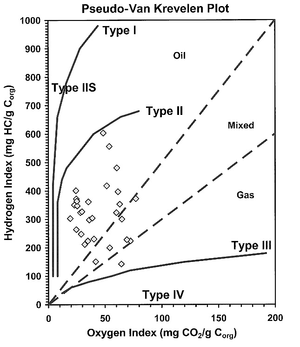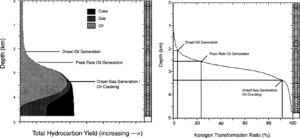Kerogen
| Exploring for Oil and Gas Traps | |

| |
| Series | Treatise in Petroleum Geology |
|---|---|
| Part | Critical elements of the petroleum system |
| Chapter | Evaluating source rocks |
| Author | Carol A. Law |
| Link | Web page |
| Store | AAPG Store |
Depositional environment is the dominant factor in determining the types of organic matter found in a rock. Only two types of organic matter are found in rocks: land derived and aquatic algae derived. Heat and pressure convert organic matter into a substance called humin and then into kerogen. Time and temperature convert kerogen into petroleum.
What is kerogen?
Geochemists[1][2] define kerogen as the fraction of sedimentary organic constituent of sedimentary rocks that is insoluble in the usual organic solvents. Kerogens are composed of a variety of organic materials, including algae, pollen, wood, vitrinite, and structureless material. The types of kerogens present in a rock largely control the type of hydrocarbons generated in that rock. Different types of kerogen contain different amounts of hydrogen relative to carbon and oxygen. The hydrogen content of kerogen is the controlling factor for oil vs. gas yields from the primary hydrocarbon-generating reactions.
Structured kerogens include woody, herbaceous, vitrinite, and inertinite. Amorphous kerogens are by far the most prevalent and include most of the algal material.
Kerogen quality

The type of kerogen present determines source rock quality. The more oil prone a kerogen, the higher its quality. Four basic types of kerogen are found in sedimentary rocks. A single type or a mixture of types may be present in a source rock. The table below lists and defines these four basic kerogen types.
| Kerogen type | Predominant hydrocarbon potential | Amount of hydrogen | Typical depositional environment |
|---|---|---|---|
| I | Oil prone | Abundant | Lacustrine |
| II | Oil and gas prone | Moderate | Marine |
| III | Gas prone | Small | Terrestrial |
| IV | Neither (primarily composed of vitrinite) or inert material | None | Terrestrial(?) |
Parameter differences
The table below shows examples of the relationships between hydrocarbon generation zones, maturity, and transformation ratio for standard types II and III kerogens, based on a specific burial and thermal history model. The most significant difference is in the depth to the onset of oil generation, where depth::1000 m separates the top of the oil windows of these two kerogen types.
| Hydrocarbon generation zone | Vitrinite refl., % Ro, Type II | Vitrinite refl., % Ro, Type III | Transformation ratio, %, Type II | Transformation ratio, %, Type III | Present-day depth, m, Type II | Present-day depth, m, Type III |
|---|---|---|---|---|---|---|
| Onset oil | 0.55 | 0.85 | 5 | 12 | 2200 | 3200 |
| Onset peak rate generation | 0.65 | 1.00 | 17 | 31 | 2600 | 3500 |
| Onset gas/cracking liquids | 0.95 | 1.35 | 88 | 64 | 3400 | 4050 |
Transformation ratio
When we compare hydrocarbon generation curves and transformation ratio curves from 1-D models, we can develop a relationship in a way similar to that for generation-maturity. If vitrinite reflectance data are available, the relationship between transformation ratio and maturity can be used to predict (1) percentage of kerogen that has generated hydrocarbons at a given depth and (2) hydrocarbon yields.
Example
Based on Figure 1, we determine that at a depth of length::2.6 km the modeled well is presently in the oil generation zone and approximately 25% of the kerogen in the source rocks at this depth has generated hydrocarbons. We know from the hydrocarbon generation-maturity relationship that at length::2.6 km this well has a vitrinite reflectance ( Ro) of 0.7%. If another well in the basin contains similar source rocks and has a maturity of 0.7% Ro at length::3.7 km, then we can predict that the section at length::3.7 km is mature for liquid generation and has generated a liquid hydrocarbons, converting approximately 25% of its kerogen to hydrocarbons.

See also
- Rock Eval analysis using hydrogen index (HI) and oxygen index (OI)
- Kerogen type and quality: visual assessment
- Pyrolysis gas chromatography
- Relationships between maturity and hydrocarbon generation
- Kerogen type and hydrocarbon generation
- Kerogen type and maturity
- Kerogen type and transformation ratio
- Open- vs closed-system generation modeling
References
- ↑ Durand, B., 1980, Sedimentary organic matter and kerogen: definition and quantitative importance of kerogen, in Durand, B., ed., Kerogen: Techniq, p. 13–14.
- ↑ Tissot, B., P., Welte, D., H., 1984, Petroleum Formation and Occurrence, 2 ed.: New York, Springer-Verlag, 699 p. The best overall reference for petroleum geochemistry.
- ↑ Dembicki, H., 2009, Three common source rock evaluation errors made by geologists during prospect or play appraisals: AAPG Bulletin, vol. 93, issue 3, pp. 341-356.